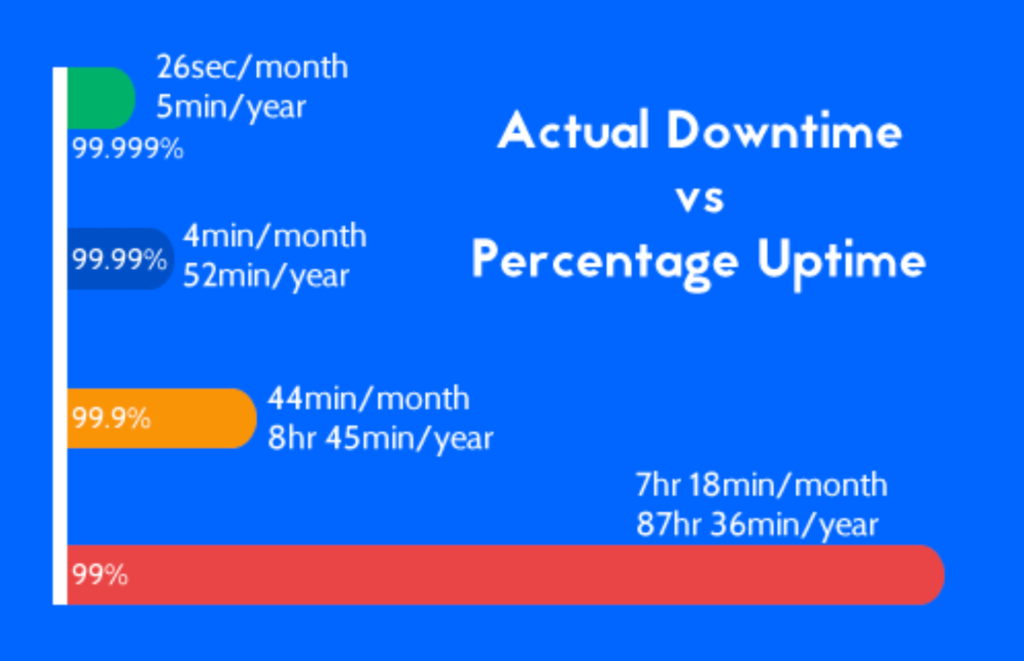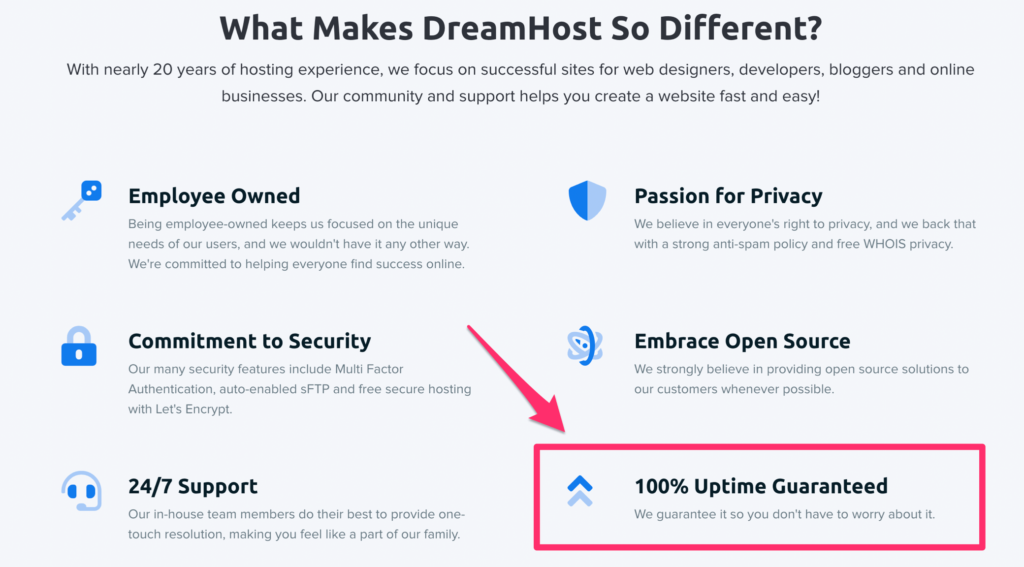Uptime is the most important part of hosting your website. This should be the first thing you use to evaluate the quality of a potential hosting provider.
What exactly is uptime?
By definition, this is the amount of time that the server hosting your website is up and running. Uptime rates are typically listed as a percentage, such as 99.95%.
If a hosting provider has strong uptime rates, then it’s a good indication that their servers perform well. So if you choose a provider based on this metric, then you can assume that your site will stay up and running nearly all of the time.
The problem with choosing a web hosting plan based on uptime is that it’s tough to independently verify claims made by different web hosts. Nearly every hosting provider will claim to have high uptimes, which forces you to take their word for it.
That’s why I created this guide.
I want to clarify any misconceptions about uptime rates in web hosting. I’ve done the research and identified the web hosts with the best uptime rates to help you make an informed decision.
Whether you’re creating a new website or you’re planning to switch hosting providers for your existing site, this resource will be a valuable reference.
Why is Uptime Important?
Imagine this—a user lands on your website and it doesn’t load. Now what?
88% of online consumers are less likely to return to a website after having a bad experience. I think it’s safe to say that a down website falls into this category.
You spend so much time, money, and effort finding different ways to drive traffic to your site. But if the site isn’t live up and running when people arrive, it’s a major concern.
Every second that your website is down has a direct impact on the success of your website.
Downtime causes lost sales, missed lead generation opportunities, and creates a negative perception about your brand in the eyes of the consumer. Think about it for a minute. What would your impression be of a website that wasn’t loading when you tried to access it? You’d probably just look elsewhere for your needs.
A 99% uptime rate might sound good. But if you translate that percentage into time, you’ll quickly realize that is not the case.

If your site was up for 99% of the time, it would be down for more than 3.5 days throughout the year.
I wouldn’t consider a provider offering anything less than 99.9% uptime, which is typically the industry standard. But as you can see from the graph above, there is still a drastic difference between 99.9% uptime and 99.99% uptime rates.
Uptime also has a direct impact on your SEO ranking. If your site is down frequently, Google and other search engines will penalize you for it.
Best High Uptime Web Hosting Providers
There are plenty of hosting providers out there delivering high uptime rates. But with that said, you shouldn’t choose a plan based solely on uptime.
You’ll be out of luck if your provider has high uptime rates but poor customer support. When your site goes down (which it will eventually) then you’ll want a provider that is easily accessible and acts quickly.
The providers below all have strong uptime rates as well as other factors that make a great web host.
HostGator
More than 8 million domains are hosted on HostGator. This provider offers a 45-day money-back promise and a 99.9% uptime guarantee on all shared hosting plans.
If HostGator fails to meet this guarantee, they’ll issue a credit for one month of your plan. You just need to create a support ticket within 30 days of the month that it happened.
The 99.9% uptime guarantee only applies to HostGator’s shared and reseller plans. Dedicated servers are prorated based on the amount of downtime.
HostGator is very affordable. Even the highest-tiered shared plans start at less than $6 per month.
Another reason why I recommend HostGator is because they offer 24/7 support 365 days per year via phone and live chat. So if your site is down for any reason, you’ll be able to get in touch with their team to straighten everything out.
For some of the best uptime rates on the market, you should consider using HostGator Cloud. These plans are priced higher than their traditional shared options, but it’s the best way to scale your server resources. You can read my full HostGator Cloud review here.
Media Temple
Media Temple has a 99.99% uptime promise. They call it the “DV 20/20 uptime guarantee” because they refund 20% of your monthly fee for every 20 minutes of downtime. This is one of the best promises on the market, although there are some contingencies.
This guarantee is only offered for the DV (developer) plans. Those are self-managed and managed VPS plans starting at $30 per month and $55 per month, respectively.
Media Temple defines uptime as the server having power, being connected to the internet, and responding to a ping.
Scheduled maintenance, repairs, emergency maintenance, DDoS attacks, outages due to programming environments, and problems caused by you or your location are not covered under this promise.
Credits max out if you reach 100% of your monthly billing rate. In order to receive this credit, you must request it from Media Temple within five days of the occurrence.
SiteGround
SiteGround is one of the most reputable names in the web hosting industry. They have outstanding customer service and deliver 99.99% uptime rates.
The reason why SiteGround’s uptime rates are so strong is because of the technology that they use. This provider uses Linux containers that remain stable during unexpected traffic surges. The technology is resource-efficient, meaning that servers won’t be overloaded very easily.
SiteGround’s staff leverages technology to proactively monitor all of the servers in-house.
This monitoring system makes it easy for SiteGround to quickly identify and fix any errors that are causing downtime. Furthermore, by actively monitoring servers, they are able to predict potential problems and prevent them before any downtime occurs.
SiteGround uses AI to prevent brute force attacks that can cause downtime. This solution can stop up to 2 million attacks per hour across all servers.
Shared hosting plans from SiteGround start as low as $3.95 per month.
DreamHost
With a 100% uptime guarantee, DreamHost’s promise is unmatched by its competitors. Even with such a significant uptime promise, DreamHost offers some of the most affordable plans on the market today.
If DreamHost fails to meet this promise, they will credit you one day of hosting for every one hour of downtime, up to 10% of your next renewal fee.
Like most hosting providers, there is a catch to this policy. DreamHost only starts assessing downtime once you open a support ticket reporting the problem.
That’s why you need to have a web monitoring service that will notify you whenever your site goes down. But we’ll talk about that in greater detail later.
More than 1.5 million websites use DreamHost for web hosting. DreamHost also offers a 97-day money-back guarantee, which is the best I’ve seen in the industry.
A2 Hosting
In addition to uptime, speed is one of the most important factors to consider when you’re evaluating a web hosting provider. A2 Hosting specializes in speed.
Aside from being one of the fastest providers in the industry, A2 Hosting also delivers a commitment to 99.9% uptime.
A2 credits its customers 5% of the monthly fee for every hour that the site is down. Although downtimes caused by DDoS attacks, network conditions outside of their network, browser issues, caching issues, and ISP network issues aren’t covered in this policy.
Any scheduled maintenance won’t count towards downtime either.
A2 Hosting offers shared, VPS, and dedicated plans. All of which are fast and reliable. If you’re looking for an industry-leader in web hosting, A2 and its strong uptime should be a top consideration.
Understanding Uptime “Guarantees”
Most web hosting providers will offer an uptime guarantee as a selling point. But those guarantees don’t necessarily deliver the results that you’re looking for.
A 99.9% uptime guarantee doesn’t mean that your site will be up and running 99.9% of the time. It usually means that you’ll be credited for any downtime below that promise.
Don’t take uptime guarantees at face value. You need to read the fine print to truly understand what different providers are offering you.
Some uptime guarantees have lots of contingencies. For example, a hosting provider may not count planned server maintenance as qualified downtime. Theoretically, your site could be down for an entire day and you’d receive no compensation for it.
The compensation for downtime is insignificant compared to the amount of money your site is losing as the result of that downtime. So don’t get too excited about a credit or refund. However, a provider’s willingness to offer this type of compensation is usually a good indication of their uptime performance.
Other hosting providers cap the amount that they’ll refund you up to a certain percentage of a plan. Factors like natural disasters, Internet failure, or hacks might not be covered in an uptime guarantee either.
Basically, you can’t just blindly choose a web hosting provider because their homepage guarantees a 99.9% uptime. You need to dig deeper and find out what that means.
What Causes Downtime?
In a perfect world, your website will be up and running 100% of the time from the day you launch it until forever. But that’s just not going to happen.
Even the best web hosting providers have some outages. Here are some common causes of downtime:
- Scheduled maintenance
- Server overloads
- Security threats
- Hardware issues
- Software issues
- Human error
- DNS issues
- CMS issues
- Power outages
- Natural disasters
As you can see, there are plenty of reasons why your website might be down. It can’t always be attributed to just one thing.
It’s also important to understand that not all downtime is the same.
For example, scheduled server maintenance from 2:00 AM to 4:00 AM on a Sunday morning is different than a crash at noon on a weekday. The former won’t be as harmful as the latter.
Furthermore, the type of website you have can also affect the impact of your downtime. A small personal blog with less than 5,000 visitors per month will survive if its down for an hour. But an ecommerce site with one million monthly visitors would suffer major losses if the site went down unexpectedly.
How to Improve Your Website Uptime
While certain causes of downtime are out of your hands, there are still steps you can take to ensure high uptime rates for your website.
Choose a Reliable Hosting Provider
The first step to high uptime is finding the best hosting provider for your website. While an uptime guarantee is nice to have, I’d rather have a host that delivers on their promise as opposed to simply offering credits as compensation.
Look for hosting providers that have a proven track record in the hosting industry. Customer support is also a top evaluating factor.
If your site goes down, you need to make sure that your hosting provider acts quickly to fix the situation. Find a host that offers 24/7 support so you can call or live chat with an agent as soon as something goes wrong.
All of the providers on the list above are reputable and come highly recommended by our team here at Quick Sprout. So this is a great place for you to start.
Use a Website Monitoring Service
Without a website monitoring service, your site could be down and you won’t even know it. But with website monitoring, you can track the performance of your site and be notified immediately in the event of any downtime.
This gives you the chance to ensure that your hosting provider is doing their job. You can contact your provider to see what steps they are taking to get your site back up and running.
While most hosting providers don’t have the reputation for being dishonest, website monitoring is the best way to know for sure if your guarantees are being met.
Change Your Hosting Plan Type
As you can probably imagine, the type of web hosting plan you have will impact the performance of your website. Uptime definitely falls into the performance category.
Shared web hosting is the most susceptible to downtime because you’re sharing servers and resources with other websites. A problem or traffic spike on one website could potentially bring all sites on that server down.
VPS hosting and dedicated server plans will come with more resources, so there won’t be as much strain on the servers being used by your site. Your site will still be susceptible to downtime related to maintenance, but traffic spikes would be an unlikely cause.
Cloud hosting plans are another hosting option that will increase your uptime rates. This type of hosting involves multiple servers across a network. So if one goes down, your site can stay running on the others.
Use a CDN (Content Delivery Network)
A content delivery network, better known as a CDN, is a way to unload some of your site’s content on servers that are closer to your website visitors.
CDNs are typically used to increase the speed of a website, but they can also prevent incidents that cause downtime. If you use a CDN, then it will free up space on your main server, which reduces strain and lowers the chances of a crash due to a surge in traffic.
Some hosting providers will offer a free CDN with your hosting plan.
Conclusion
Your website is useless if people can’t access it. That’s why you need to find a web hosting provider that delivers high uptime rates.
These are the top options that I would recommend.
- HostGator — 99.9% uptime
- Media Temple — 99.99% uptime
- SiteGround — 99.99% uptime
- DreamHost — 100% uptime
- A2 Hosting — 99.9% uptime
Each of these providers is unique in their own way. For example, HostGator is best for scalable resources while Media Temple is best for developers.
So make sure you choose the provider, plan, and hosting type that best fits your needs. But regardless of which option you select, you’ll be satisfied with the uptime rates if you go with a provider on our list.
from Quick Sprout https://ift.tt/2qH8D9P
via IFTTT





